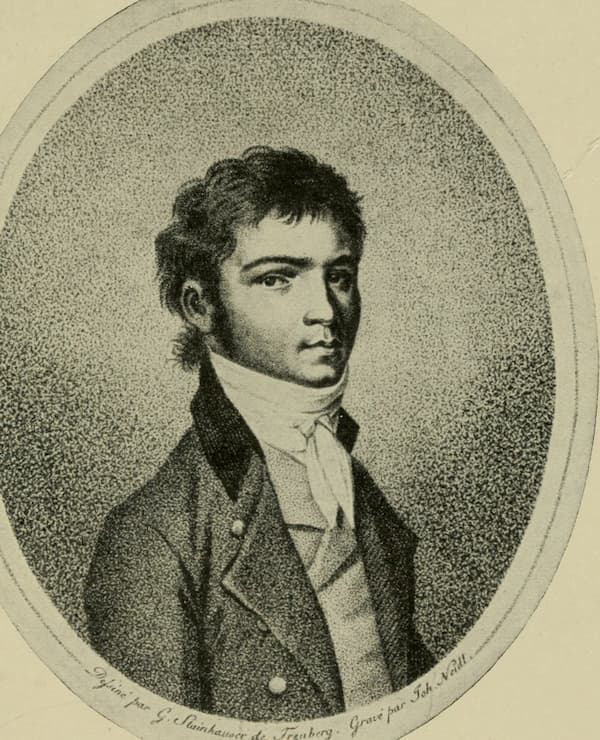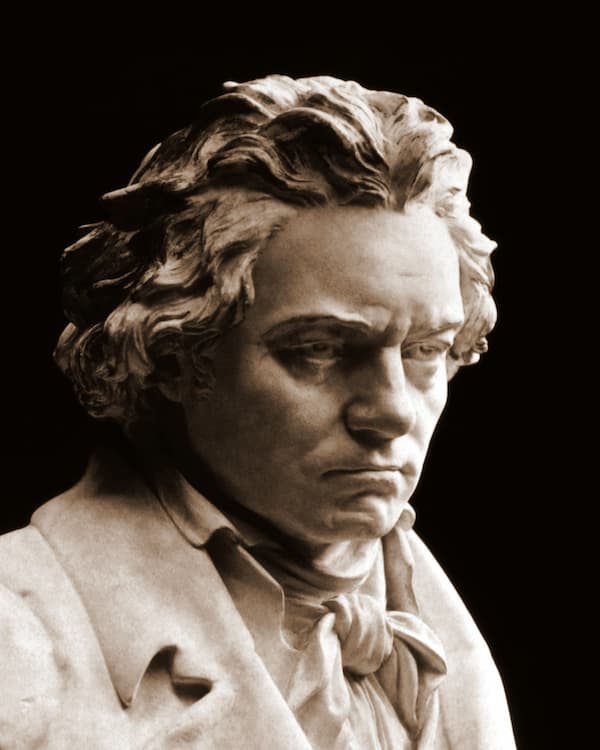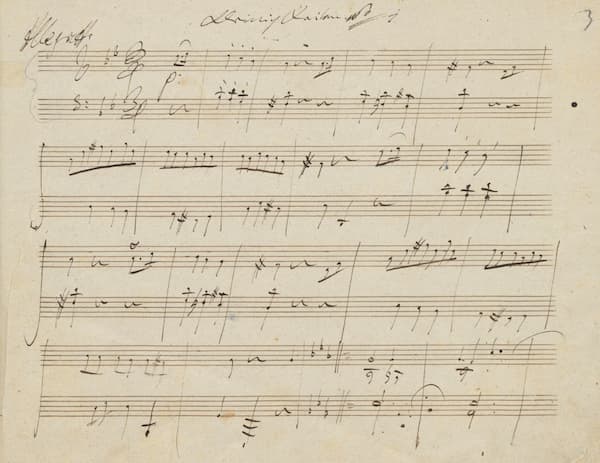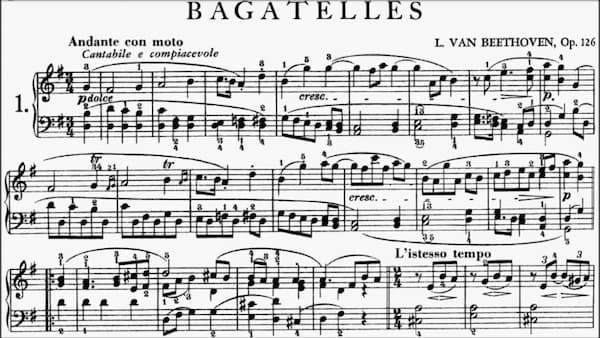Arguably, the first composer to write true piano music was Ludwig van Beethoven. To be sure, he had tremendous technical ability, and critics wrote, “He was attacking pianos with such force that during the performance, keys, hammers and strings would be flying.”

Ludwig van Beethoven at 26 years old
However, virtuosity is all but one aspect of Beethoven’s piano repertoire, as he was able to compose music with “glowing passion, exuberance, heroism, nobility and dramatic pathos.” His 32 piano sonatas and the late variation sets are at the pinnacle of piano literature, but Beethoven also composed three sets of what he titled “Bagatelles.”
Ludwig van Beethoven: 7 Bagatelles, Op. 33 “No. 1” (Melvyn Tan, fortepiano)
That particular title implies no specific form, and Beethoven himself called the first six of his Op. 119 “Kleinigkeiten,” or trifles. So, just how serious are these Bagatelles? Well, some of the bagatelles were originally planned as movements for piano sonatas but were subsequently rejected by Beethoven before publication. This seems to suggest that some of the bagatelles, as potential sonata movements, are the compositional equal to sonata movements in quality and completeness.
Ludwig van Beethoven: 7 Bagatelles, Op. 33 “No. 2” (Melvyn Tan, fortepiano)

Beethoven’s house of birth in Bonn, 2008
One thing for sure, the bagatelles are a series of short and sometimes light-hearted piano works in a variety of contrasting characters and moods. It’s hardly surprising that some scholars consider Beethoven’s bagatelles to be the first 19th-century character pieces. To celebrate Beethoven’s baptism on 17 December, let us briefly explore his Bagatelles Op. 33, Op. 119, and Op. 126.
Ludwig van Beethoven: 7 Bagatelles, Op. 33 “No. 3” (Melvyn Tan, fortepiano)
Ludwig van Beethoven: 7 Bagatelles, Op. 33 “No. 4” (Melvyn Tan, fortepiano)
Bagatelles Op. 33
The first of Beethoven’s three published sets of Bagatelles was issued in 1803 by Bureau d’Arts et d’Industrie. The surviving sketches and the nature of the music suggest that Beethoven simply compiled a number of separate pieces that originated anywhere between boyhood and the start of the new century. All 7 Bagatelles display conventional musical forms and styles, and most are written in three-part form.
Ludwig van Beethoven: 7 Bagatelles, Op. 33 “No. 5” (Paul Lewis, piano)

Photograph of bust statue of Ludwig van Beethoven by Hugo Hagen
Beethoven thoroughly revised his Bagatelles shortly before publication. At the same time, however, he was incredibly busy and worked on his Piano Concerto No. 3, the Symphony No. 2 and the oratorio “Christ on the Mount of Olives.” We still don’t know exactly why Beethoven devoted so much time to the Bagatelles, but Paul Lewis suggests that “in light of Beethoven’s rising fame, it was to satisfy a growing demand from students and amateurs for easy pieces from his pen.”
Ludwig van Beethoven: 7 Bagatelles, Op. 33 “No. 6” (Paul Lewis, piano)
We find a simple and innocent tune in No. 1, garnished with plenty of ornamentation and light-hearted transitions. No. 2 has the character of a scherzo that humorously manipulates rhythm and accents, while No. 3 appears folk-like in its melody and features a delicious change of key in the second phrase. The A-Major Bagatelle No. 4 is essentially a parody of a musette with a stationary bass pedal, and the minor-mode central section offers harmonic variety.
Beethoven provides some musical humour in No. 5 as this playful piece is a parody of dull passagework. In a really funny moment, the music gets stuck on a single note repeated over and over, like Beethoven can’t decide what to do next. In the end, he decides to repeat what he has already written before. In No. 6, we find a tune of conflicting characters, with the first phrase being lyrical and the second phrase being tuneful. The beginning of No. 7 almost suggests Beethoven’s Waldstein Sonata.
Ludwig van Beethoven: 7 Bagatelles, Op. 33 “No. 7” (Paul Lewis, piano)
Bagatelles Op. 119

Beethoven’s Bagatelles Op. 119 No. 1 manuscript
In 1823, Beethoven was finishing his late piano sonatas Op. 109, 110, and 111, and he was working on the Diabelli Variations and the Missa Solemnis. In that year, he wrote to Ferdinand Ries in London, “you are receiving six bagatelles or trifles, and again another five, which belong together, in two parts. Dispose of them as favourably as you can.” Ries sold the set to the London publisher Clementi, who issued all eleven pieces in 1823. This edition is titled “Trifles for the Piano Forte, consisting of eleven pleasing pieces composed in various styles.”
Ludwig van Beethoven: 11 Bagatelles, Op. 119 “No. 1” (Imogen Cooper, piano)
Ludwig van Beethoven: 11 Bagatelles, Op. 119 “No. 2” (Imogen Cooper, piano)
Essentially, in Beethoven’s Op. 119, we are dealing with two different collections combining old and new works. The set builds on five miniatures, which Beethoven composed in 1820 for the third and final volume of Friedrich Starke’s Wiener Piano-Forte-Schule (Viennese School of Piano Playing). Eventually, these 5 bagatelles became Nos 7-11 of Op. 119. Nos 1-5 had already been completed, or possibly sketched, much earlier and dated from around 1800. The central bagatelle in this set was the last to be composed, probably in late 1822, shortly before publication.
Ludwig van Beethoven: 11 Bagatelles, Op. 119 “No. 3” (Imogen Cooper, piano)
Ludwig van Beethoven: 11 Bagatelles, Op. 119 “No. 4” (Imogen Cooper, piano)
In the 1820s, Beethoven’s Leipzig publisher Carl Friedrich Peters was initially interested in publishing the first bagatelles but later emphatically rejected them as he wrote to Beethoven, “I’ve had them played by several people, and not one of them will believe me that they are by you. I asked for “Kleinigkeiten,” but these are really too small… I will say no more about it, other than that I will never print these but will rather lose the fee I have already paid.” And he added, “the pieces are not worth the money, and you should consider it beneath your dignity to waste time with such trivia that anyone can write.”
Ludwig van Beethoven: 11 Bagatelles, Op. 119 “No. 5” (Imogen Cooper, piano)
Ludwig van Beethoven: 11 Bagatelles, Op. 119 “No. 6” (Imogen Cooper, piano)
However, in Beethoven’s mind these miniatures were by no means inferior to his more extended piano works but “were simply ideas that were complete in themselves.” He actually enjoyed writing these little pieces, and he highly valued his “trifles.” Imogen Cooper writes, “Op. 119 form a compendium of technique and piano texture in concise form, as is appropriate for a piano tutor.” We may add, however, that Beethoven may not have always had the amateur performer in mind, given the technical challenges written into some of these “Kleinigkeiten.”
Ludwig van Beethoven: 11 Bagatelles, Op. 119 “No. 7” (Eugenio De Rosa, piano)
Ludwig van Beethoven: 11 Bagatelles, Op. 119 “No. 8” (Eugenio De Rosa, piano)
No. 1 presents a rather nostalgic opening, while a busy No. 2 unfolds with triplets surrounding the theme in the right hand. Written in the style of an Allemande, No. 3 promises a point of reflection, but it is interrupted by the opening waltz. A lyrical No. 4 is juxtaposed by an almost pompous No. 5, and No. 6 is the most varied and developed. Trills dominate No. 7, while a tranquil No. 8 features some intriguing harmonic progressions.
No. 9 unfolds in the character of a Ländler and features heavily accented syncopation. No. 10 is noteworthy because of its extreme brevity. Lasting only a few seconds and fitting into a single system of printed music, it is Beethoven’s shortest work, perhaps one of the shortest works of any composer of note. Finally, No. 11 rounds off the set in a mood of graceful contemplation.
Ludwig van Beethoven: 11 Bagatelles, Op. 119 “No. 9” (Eugenio De Rosa, piano)
Ludwig van Beethoven: 11 Bagatelles, Op. 119 “No. 10” (Eugenio De Rosa, piano)
Ludwig van Beethoven: 11 Bagatelles, Op. 119 “No. 11” (Eugenio De Rosa, piano)
Bagatelles Op. 126

Beethoven’s Bagatelle Op. 126
When Beethoven offered the Bagatelles Op. 126 to the publishers Schott & Co. in November 1824, he described them as “6 Bagatelles or Trifles for solo piano, some of which are rather more developed and probably the best pieces of this kind I have written.” Contrary to his earlier Bagatelle settings, Op. 126 was conceived as an integral group of pieces which Beethoven labelled a “cycle of little pieces.”
Designed as a unified cycle from the outset, the Bagatelles are alternately lyrical and introspective, and fast and dramatic, “with the two threads drawn together in the final number; and their keys form a descending chain of thirds, beginning in G major and minor, and ending in E flat major.” And let us not forget that Op. 126 was Beethoven’s last work for the piano offering a concentration of musical thoughts typical of his late style.
Ludwig van Beethoven: 6 Bagatelles, Op. 126 “No. 1” (Alfred Brendel, piano)
Ludwig van Beethoven: 6 Bagatelles, Op. 126 “No. 2” (Alfred Brendel, piano)
As Paul Lewis writes, “Typical of that style is a native fluency in contrapuntal writing paired with freedom from formal constraints in applying it, along with a willingness to write his contrapuntal voices several octaves apart. Beethoven, the architect of massive, great formal structures, shows himself in these pieces as a master of the miniature, deftly creating an immediate impression with his opening gestures and developing his motives with unfettered originality.”
Beethoven treats his material with a great deal of freedom, transforming it through intricate ornamentation as in No. 1. Full of driving energy, No. 2 channels the music into playful directions while the noble simplicity of No. 3 is sustained through many changes in texture. The contrapuntal opening of No. 4 is contrasted by a dream-like section, with plenty of unexpected harmonic and mood changes.
Ludwig van Beethoven: 6 Bagatelles, Op. 126 “No. 3” (Alfred Brendel, piano)
Ludwig van Beethoven: 6 Bagatelles, Op. 126 “No. 4” (Alfred Brendel, piano)
The quietly expressive No. 5 creates a gentle flow with triplet patterns and subtle syncopations, while No. 6 starts and ends with an energetic, turbulent section, framing a central, more composed segment that begins like a barcarolle. The opening Presto dismisses the slower section and the piece ends abruptly. As a commentator wrote, it ends “almost if dismissing the introspective nature of the preceding music; a fitting way for Beethoven to conclude his piano compositions.”
In terms of compositional style, the Bagatelles are comparable to the late string quartets, particularly with the second movement of Op. 132. And to be sure, the relationship between the late bagatelles and Beethoven’s late period works has been the subject of various studies. It uses the same musical language but “offers a musical universe in just a couple of minutes.”
Stylistically, the late Bagatelles looked forward to the foundations of romanticism as the expression of personal emotions became increasingly important. To some observers, Beethoven’s late Bagatelles are the first character pieces, a genre that gained unprecedented prominence later in the century. As Maurice Hinson suggests, “Beethoven’s Op. 126 are, if anything in music can be, self-portraits, as they express his moods and frame of mind the day he composed them.”
Ludwig van Beethoven: 6 Bagatelles, Op. 126 “No. 5” (Alfred Brendel, piano)
Ludwig van Beethoven: 6 Bagatelles, Op. 126 “No. 6” (Alfred Brendel, piano)
As you might have expected, we can’t really talk about Beethoven Bagatelles without mentioning the Bagatelle in A minor, WoO 59. One of the most popular short pieces by the composer, this Bagatelle goes by the nickname “Für Elise.” Probably composed around 1810, it was reworked in the early 1820s. It was first published only in 1867, four decades after the composer’s death, in an appendix to a collection of Beethoven letters and hitherto unknown works.
The inscription “Für Elise” remains a mystery, and various theories suggest young women in or around Beethoven’s circle. The distinctive theme with the repeated neighbour-note is supported by arpeggiated chords shared between the hands. As a scholar reports, in some of the sketches from the early 1820s, Beethoven contemplated “a somewhat more sophisticated layout of the arpeggios, but these did not find their way into a definite version of the work.”
The Beethoven Bagatelles offer a diverse and evolving body of work, displaying the composer’s creative exploration in this genre of short and expressive piano pieces. They evolved from playful themes and structure to pieces of greater sophistication by blending dense harmonic landscapes with sudden shifts in mood, texture, and rhythm.
For more of the best in classical music, sign up for our E-Newsletter



I ow my introduction to Music to my father and to the mother, daughter and aunt who played ” An Elise” (and others) in the apartment above ours.